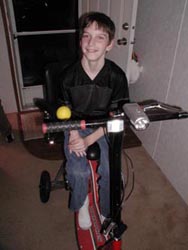Designers: Kevin Ko, Aya Eguchi, and Eric Schwartz
Client Coordinator: Jodi Petry, Lenox Baker Hospital
Supervising Professor: Larry Bohs
 A Schwinn S180 electric scooter was modified for safe and comfortable use by an eleven-year-old boy with right-side hemiplegia. The modifications aid with balance, steering, and comfort, as well as limiting the maximum speed. As a result, the client can safely and comfortably ride the scooter, which he was unable to do previously.
A Schwinn S180 electric scooter was modified for safe and comfortable use by an eleven-year-old boy with right-side hemiplegia. The modifications aid with balance, steering, and comfort, as well as limiting the maximum speed. As a result, the client can safely and comfortably ride the scooter, which he was unable to do previously.
How this project helped
The modified scooter allows our client to use his electric scooter comfortably, independently, and safely. He can now ride with family and friends during trips to the beach, thereby fostering self-confidence. In a letter, the client said, “Thank you very much for all the hard work you all did on my scooter. I will be able to ride with my brothers and sister and not be left sitting out watching them have all the fun. I won’t have to work as hard as them! I’ll be the coolest kid in the neighborhood with the coolest ride! Thank you.”
The modified scooter (Figure 1) includes: 1) a foot guard to prevent the right foot from falling off the scooter, 2) modified handlebars to facilitate left-handed control, 3) a stabilizing mechanism for help with balance, 4) a modified seat and right arm support to maintain the client’s posture while riding, and 5) a speed governor to maintain a safe operating speed.
The foot guard was made from aluminum sheet metal, which we molded to the contour of the floorboard’s right, outer edge. The metal wraps around the under side of the floorboard and is attached by four countersunk 3/16” flat headed bolts. The top edge of the foot guard extends 1.5” from the bottom edge, which is sufficient to block a foot from sliding off that side of the scooter.
The handlebars were modified to reside closer to the client’s body and facilitate steering with the left hand. Two sections of aluminum tubing, 8” long, were attached to provide an L-shaped extension to the original bar. The throttle and hand brake were attached to this extension, bringing the scooter controls 8” closer to the user’s body.
A robust pair of training wheels (Fatwheels, Mechanical Innovations, Inc, Charlotte, NC) was attached to aid the client’s balance. One-inch axle extenders were added to properly attach the Fatwheels. During testing of this mechanism, excessive stress on the training wheels caused the mounting bracket to bend. Therefore, an additional triangular plate was welded to the bracket, and a larger-diameter axle extender was created and attached.
 Because the client found it difficult to maintain his posture with the original seat, we purchased and mounted an 18” highback seat (Freedom Concepts, Inc., Winnipeg, MB), which included side-supports. A custom armrest was fabricated from a sheet of aluminum, slightly curved to an arm’s contour, lined with an adhesive foam and Poly-Fil, and covered with black vinyl. The armrest was supported by two aluminum shafts, one attached to the backrest, and one attached to the bottom of the seat. A ball was attached to the end of the armrest to provide a gripping surface for the right hand.
Because the client found it difficult to maintain his posture with the original seat, we purchased and mounted an 18” highback seat (Freedom Concepts, Inc., Winnipeg, MB), which included side-supports. A custom armrest was fabricated from a sheet of aluminum, slightly curved to an arm’s contour, lined with an adhesive foam and Poly-Fil, and covered with black vinyl. The armrest was supported by two aluminum shafts, one attached to the backrest, and one attached to the bottom of the seat. A ball was attached to the end of the armrest to provide a gripping surface for the right hand.
A mechanical speed governor was implemented to limit the maximum speed of the scooter, which was too high for initial use. Three holes were drilled in the throttle mechanism to accept setscrews, such that three different maximum speeds could be selected. In this way, the client’s parents can gradually increase the maximum speed of the scooter as the client becomes more skilled and comfortable.
Figure 2 shows the client using the scooter. Cost of parts for the scooter modifications was about $500.